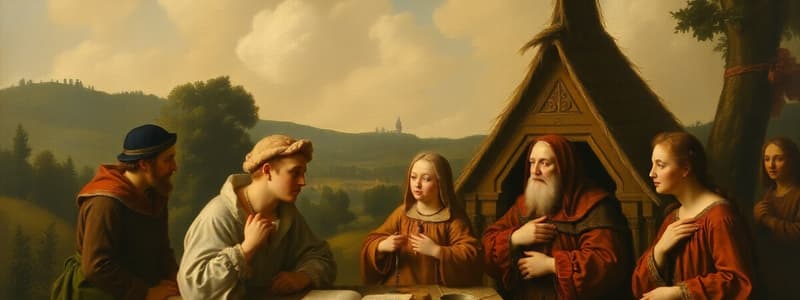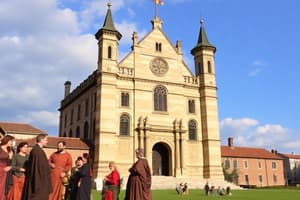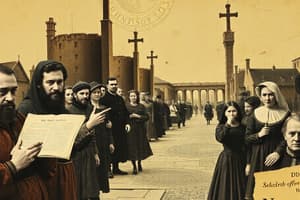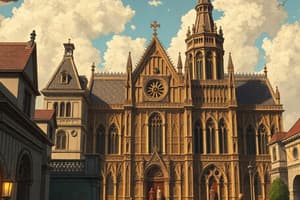Podcast
Questions and Answers
Which assertion accurately captures a core tenet of humanism during the Renaissance?
Which assertion accurately captures a core tenet of humanism during the Renaissance?
- Strict adherence to established religious doctrines and traditions.
- Rejection of classical texts and artistic styles in favor of medieval scholasticism.
- Emphasis on divine will as the primary driver of human events.
- Focus on individual potential and achievements, diverging from sole religious focus. (correct)
In what way did the rediscovery of classical texts influence the Renaissance?
In what way did the rediscovery of classical texts influence the Renaissance?
- It reinforced the dominance of religious dogma and suppressed scientific inquiry.
- It led to widespread social unrest and political instability throughout Europe.
- It caused a decline in urban centers and a resurgence of feudalism.
- It fostered a renewed interest in classical art, literature and philosophy, inspiring new artistic and intellectual movements. (correct)
How did the rise of wealthy merchant families, like the Medici, contribute to the flourishing of the Renaissance in Italian city-states?
How did the rise of wealthy merchant families, like the Medici, contribute to the flourishing of the Renaissance in Italian city-states?
- By diverting resources away from artistic endeavors to fund military campaigns and territorial expansion.
- By imposing strict regulations on artistic production and limiting access to education for common citizens.
- By becoming patrons of the arts, commissioning works, and fostering a cultural environment conducive to creativity. (correct)
- By controlling trade routes and suppressing artistic expression to maintain political power.
What role did the printing press play in spreading Renaissance ideals throughout Europe?
What role did the printing press play in spreading Renaissance ideals throughout Europe?
How did Renaissance art depart from medieval artistic traditions?
How did Renaissance art depart from medieval artistic traditions?
What factors contributed to the rise of secularism during the Renaissance?
What factors contributed to the rise of secularism during the Renaissance?
How did the concept of the 'Renaissance Man' reflect the values of the period?
How did the concept of the 'Renaissance Man' reflect the values of the period?
How did the northern Renaissance differ from the Italian Renaissance?
How did the northern Renaissance differ from the Italian Renaissance?
What was the significance of vernacular literature during the Renaissance?
What was the significance of vernacular literature during the Renaissance?
How did Christian humanists seek to reform society?
How did Christian humanists seek to reform society?
What were the key criticisms leveled against the Catholic Church prior to the Reformation?
What were the key criticisms leveled against the Catholic Church prior to the Reformation?
How did Martin Luther's teachings challenge the authority of the Catholic Church?
How did Martin Luther's teachings challenge the authority of the Catholic Church?
What were the main points of Martin Luther's teachings?
What were the main points of Martin Luther's teachings?
What was the significance of the Peace of Augsburg in 1555?
What was the significance of the Peace of Augsburg in 1555?
How did Henry VIII's quest for a male heir lead to the English Reformation?
How did Henry VIII's quest for a male heir lead to the English Reformation?
How did Elizabeth I navigate religious tensions in England during her reign?
How did Elizabeth I navigate religious tensions in England during her reign?
What were the core tenets of Calvinism?
What were the core tenets of Calvinism?
How did Calvin's concept of theocracy influence the city of Geneva?
How did Calvin's concept of theocracy influence the city of Geneva?
What were the key beliefs and practices of the Anabaptists?
What were the key beliefs and practices of the Anabaptists?
How did the Catholic Church respond to the challenges posed by the Protestant Reformation?
How did the Catholic Church respond to the challenges posed by the Protestant Reformation?
What were the main goals of the Jesuits?
What were the main goals of the Jesuits?
What were the key outcomes of the Council of Trent?
What were the key outcomes of the Council of Trent?
What was the lasting impact of the Reformation on Europe?
What was the lasting impact of the Reformation on Europe?
In what ways did the Reformation contribute to the rise of modern nation-states?
In what ways did the Reformation contribute to the rise of modern nation-states?
How did the Renaissance and Reformation influence subsequent intellectual movements?
How did the Renaissance and Reformation influence subsequent intellectual movements?
Which factors were essential in paving the way for the Renaissance?
Which factors were essential in paving the way for the Renaissance?
What role did art patronage play during the Renaissance, and how did it shape the artistic landscape of the time?
What role did art patronage play during the Renaissance, and how did it shape the artistic landscape of the time?
What distinguished the art and literary works of the Renaissance from those of the Middle Ages?
What distinguished the art and literary works of the Renaissance from those of the Middle Ages?
What impact did the rise of city-states in northern Italy have on intellectual exchange and innovation during the Renaissance?
What impact did the rise of city-states in northern Italy have on intellectual exchange and innovation during the Renaissance?
How did the Black Death influence social and economic structures in Europe, and what implications did this have for humanism's rise?
How did the Black Death influence social and economic structures in Europe, and what implications did this have for humanism's rise?
In what ways did Renaissance society enable women to partake in cultural and intellectual life, and which limitations restricted the contribution?
In what ways did Renaissance society enable women to partake in cultural and intellectual life, and which limitations restricted the contribution?
How can Niccolò Machiavelli's political philosophy reflect the social and moral values of the Renaissance era?
How can Niccolò Machiavelli's political philosophy reflect the social and moral values of the Renaissance era?
While humanist ideals fostered creativity during The Renaissance, what challenges did Renaissance artists and intellectuals encounter?
While humanist ideals fostered creativity during The Renaissance, what challenges did Renaissance artists and intellectuals encounter?
How did the advent of the printing press revolutionize the spread of knowledge and ideas during the Reformation?
How did the advent of the printing press revolutionize the spread of knowledge and ideas during the Reformation?
To what extent did Renaissance values of humanism and individualism shape the course of the Protestant Reformation, and what outcomes resulted?
To what extent did Renaissance values of humanism and individualism shape the course of the Protestant Reformation, and what outcomes resulted?
What was the effect of the new attitudes toward faith as proposed by Martin Luther?
What was the effect of the new attitudes toward faith as proposed by Martin Luther?
How did European exploration and expansion during the Renaissance facilitate cross-cultural exchange, and what are the impacts?
How did European exploration and expansion during the Renaissance facilitate cross-cultural exchange, and what are the impacts?
In what ways did the Renaissance and Reformation contribute to shifts in political thought and governance?
In what ways did the Renaissance and Reformation contribute to shifts in political thought and governance?
What key social, economic and political factors explain the start of the Reformation?
What key social, economic and political factors explain the start of the Reformation?
What long-term consequences did the Reformation have?
What long-term consequences did the Reformation have?
Flashcards
What is the Renaissance?
What is the Renaissance?
A period of European history, from 1300 to 1600, that saw a rebirth of art and learning.
What is humanism?
What is humanism?
An intellectual movement focused on human potential and achievements.
What does secular mean?
What does secular mean?
Worldly rather than spiritual and concerned with the here and now.
What is a patron?
What is a patron?
Signup and view all the flashcards
What is perspective?
What is perspective?
Signup and view all the flashcards
What is vernacular?
What is vernacular?
Signup and view all the flashcards
What is The Courtier?
What is The Courtier?
Signup and view all the flashcards
Who was Leonardo da Vinci?
Who was Leonardo da Vinci?
Signup and view all the flashcards
Vernacular language
Vernacular language
Signup and view all the flashcards
What is Utopia?
What is Utopia?
Signup and view all the flashcards
What is the Elizabethan Age?
What is the Elizabethan Age?
Signup and view all the flashcards
Who was Johann Gutenberg?
Who was Johann Gutenberg?
Signup and view all the flashcards
What is an indulgence?
What is an indulgence?
Signup and view all the flashcards
The reformation
The reformation
Signup and view all the flashcards
Who are Protestants?
Who are Protestants?
Signup and view all the flashcards
What is excommunication?
What is excommunication?
Signup and view all the flashcards
What was the Edict of Worms?
What was the Edict of Worms?
Signup and view all the flashcards
Definition of slavery
Definition of slavery
Signup and view all the flashcards
What is Protestantism?
What is Protestantism?
Signup and view all the flashcards
What was the Peace of Augsburg?
What was the Peace of Augsburg?
Signup and view all the flashcards
What is annul?
What is annul?
Signup and view all the flashcards
What is the Anglican Church?
What is the Anglican Church?
Signup and view all the flashcards
What is predestination?
What is predestination?
Signup and view all the flashcards
What is a theocracy?
What is a theocracy?
Signup and view all the flashcards
Who are the Anabaptists?
Who are the Anabaptists?
Signup and view all the flashcards
What is the Catholic Reformation?
What is the Catholic Reformation?
Signup and view all the flashcards
Study Notes
European Renaissance and Reformation Overview
- The period from 1300-1600 saw Europe change dramatically in social and cultural life.
- It all started with the rediscovery of ancient manuscripts by trading with the East, Europeans developed a new ideas about culture and art.
- This time was known as the Renaissance or Rebirth.
- Martin Luther aimed to reform Catholic Church practices, which led to the Reformation.
- It brought about new non-Catholic churches.
- Books and pamphlets became cheaper and easier to produce, revolutionizing the spread of Renaissance and Reformation ideas, especially thanks to the printing press.
Examining Art: "The Madonna of Chancellor Rolin"
- Jan van Eyck's painting of Chancellor Rolin is a portrait for a museum.
- It highlights classical styles through its columns, and the influence of Renaissance art can be studied from it.
- van Eyck uses the technique of perspective.
- Mary and the infant Jesus represents a new vision of ancient culture brought into the Europe of the Renaissance.
- Rolin wears a fur-trimmed robe showing his high status and importance of the individual.
- Beauty is captured in the details such as the design on the floor, folds of Mary's cloak and the scenery
Italy: Birthplace of the Renaissance
- The Italian Renaissance, a rebirth of learning, occurred due to Europe's need to celebrate life and question old institutions after war and plague.
- The need to experiment with new styles and express a new spirit drove Northern Italy's writers and artists.
- Creativity boomed in art, writing, and thought from 1300 to 1600, which was called the Renaissance.
- "Renaissance" means rebirth.
- Italian scholars wanted to revive Greek and Roman culture while also creating something new and innovative, leading to new artistic and literary styles with innovative value placed on the individual.
- Thriving cities, a wealthy merchant class, and classical Greek/Roman heritage gave Italy the advantages that would made it the birthplace of the Renaissance .
- The bubonic plague in the 1300s killed 60% of the population, which led to higher wages and merchants pursuing art due to fewer business opportunities and people searching for answers in their lives..
- A wealthy merchant class developed within Italian, like Milan and Florence where people were intensely evolved in business
- Merit, not inheritance, determined social rank for merchants.
- Individual achievement was very important during the Renaissance
The Medici Family
- Florence was a city-state led by the wealthy Medici banking family.
- Cosimo de Medici controlled Florence's government for 30 years via loans and influence, not political office and his grandson Lorenzo de Medici later came to power.
- Renaissance scholars dismissed Middle Age art and literature preferring to return to Greek and Roman learning.
- Artists and scholars found inspiration in Roman ruins..
- Roman texts were preserved in monasteries and Greek scholars fled the Turks in Constantinople and sought refuge in Rome and helped contribute greatly to Renaissance.
Classical and Wordly Values in Italy
-
Studying classical manuscripts led to humanism.
-
Humanism focused on human potential and achievements.
-
Classical texts help promote the value of old traditions like history, literature, and philosophies to influence artists and architects.
-
Wealthy citizens enjoyed material luxuries.
-
Renaissance society was more secular than spiritual.
-
Church leaders were also becoming more worldly to enjoy life and wealth.
-
Church leaders and wealthy families beautified cities by becoming patrons of the arts.
The Renaissance Man
- Renaissance men wanted to master every area of study and create art.
- They strived to be "universal men."
- Baldassare Castiglione wrote "The Courtier" which is about how to become a Renaissance man, charming, witty, educated, skilled in dance/music/poetry, riding, wrestling, and swordsmanship
- Upper-class women had to be charming and educated in the classics, but did not seek fame and they inspired, but did not create art.
- They also had less political influence than Renaissance men, but a few women like Isabella d'Este exercised power.
Isabella D'Este
- As ruler of Mantua was born into the ruling family of Ferrara.
- She brought Renaissance artists to her court and built a famous art collection and Isabella was skilled in politics.
Revolutionizing Art
- Artists were supported by patrons like Isabella d'Este in Northern Italy and Renaissance art changed in style from religious ideals for medieval artists to realistic portrayals of subjects and Greek/Roman themes.
- Renaissance painters used perspective and three dimensions on flat surfaces to follow the new emphasis on individuals.
- Painters created realistic portraits that revealed what was distinct about each individual in addition to realism being used to reflect the human body.
- Michelangelo was a sculptor, architect, poet, and painter.
- Donatello revived classical form with his free-standing nude statue of David, sculpted in the 1460s.
Leonardo da Vinci
- Leonardo da Vinci was a painter, sculptor, inventor, and scientist and true "Renaissance man," interested in how things worked and how he showed his passion on his art.
- Leonardo famous creations Mona Lisa and the last supper shows the personalities of Jesus' disciples through facial expressions.
- Raphael Sanzio known for his use of perspective created gentle and calm expressions in his portrayals of the Madonna.
- He painted famous Renaissance figures in his School of Athens, including Michelangelo, Leonardo, and himself.
- Women Renaissance artists like Sofonisba Anguissola and Artemisia Gentileschi rose to fame.
Renaissance Writers
- Renaissance writers followed Dante's example by writing in the vernacular, or native language, while writing for self-expression to portray an idea or a subject.
- Petrarch wrote Italian sonnets about his ideal Laura and classical Latin letters and writings for self expression.
- Giovanni Boccaccio known for the Decameron writes stories about the human condition that involves cutting humor.
- Niccolo Machiavelli wrote "The Prince" in 1513 as a political guidebook.
Machiavelli's Beliefs
- Machiavelli thought that a prince should gain and keep power by being strong like a lion and shrewd like a fox.
- He should mislead people and lie to opponents for the good of the state versus just being kind and acting with integrity.
Vittoria Colonna
- Renaissance women usually wrote about personal subjects, not politics but gained fame from the art in Rome.
- She wrote emotional poems due to the effect and effects of the war.
Global Rennaissance Parallels
- The Tang and Song Dynasties' artistic and technological advancements had roots in an earlier time.
- China prospered with poetry, architecture, painting, and pottery and also produced important tools like gunpowder and printing.
Northern Renaissance
- From 1400 on, the Italian Renaissance concepts impressed merchants and scholars and began to impress other figures.
- By the late 1400s, the Renaissance touched Northern Europe; especially England, France, Germany, and Flanders.
- Northern Europe started to grow again after being stunted by the Bubonic Plague.
- The Hundred Years' War ended in 1453, leading to population growth and wealthy urban merchants sponsoring artists.
- Flanders first grew due to long-distance merchant trade and the cloth, wool industry.
- Wealth continued to rise throughout other parts of Northern Europe increased patronage of artists.
- In Contrast to Italy, the monarchs hired workers to purchase paintings and by supporting artists and Northern Europe combined Italian Renaissance ideas to develop its own character.
Reformation
- The Italian humanism led Northerns to examine Christian texts and Church teachings.
- Critical humanists who were against the failure of the Christian Church gave way to the reforms of society and the creation of schooling for both boys and girls.
Major Figures
- Albrecht Dürer of Germany was a famous artist who traveled to Italy to study.
- He did woodcuts and engravings of religious subjects to promote the Renaissance.
- Hans Holbein the Younger a German artist who lived in England specialized in photography and portraits.
- Trade from wealthy Flemish merchant families made their region the center for artists.
- Jan van Eyck was the first painter in the region.
- He used and developed the use of oil based paints.
- Van Eyck paintings reflected character and realistic and influenced Northern Europe artists.
- Flemish painting reached its peak with Pieter Bruegel the Elder in 1550.
- His interests and skills involved portraying individual people and scenes from everyday peasant life.
Important Writers
- Some writers followed medieval writer Dante.
- They wrote native versus Latin in addition to writing portrayals for self-expression of the individuality, these writers helped create modern literature.
- Erasmus of Holland wrote about the importance of studying the Bible.
- He poked fun at merchants and pompous priests and tried to encourage everyone to create and model their own societies.
- Thomas More wrote Utopia, no place, meant to express the need and need to remove greed corruption to create an ideal world.
- Christine de Pizan wanted to ensure that women were educated too.
The Elizabethan Age
- This spread from England to mid 1500 and Queen Elizabeth did her part to support the development in her region.
- William Shakespear was the most famous writer and playwright and wrote many poems and plays and revered the classics to understand love the English.
- Renaissance shows human being and delivers a high idea and view of human nature.
Printing Press and Gutenberg
- Chinese invented "Block Printing" as a method to use letter to print wood.
- Bi Sheng invented movable type for each character.
- To satisfy the amount of info Renaissance demand, Johannes Gutenberg a German craftsman helped improve by using a printing press..
- The complete version of his bible printed in 1455 was able to copy books at an incredible speed and lower cost to print.
- This meant it produced religious texts early on and eventually began printing other works from medicine to guides.
Legacy of the Renaissance
- This era focused on social and artistic change
- Instead of being focused on the church there was an important newfound belief in the individual
- Printing's impact was huge and some historians argued it was more revolutionary than the arrival of computers.
- Techniques and styles of classical Greece and Rome were embraced in the arts and portrayed nature and individuals with newfound realism.
- Secular and relgious themes increased.
- Vernacular languages began as a means to express ideas from writers
- Society changed due to the increase of books that created more availability of knowledge and increased literacy which led to increase desire to learn and read
- Law and charters were published and it made them more clearer and available
- Christian Humanists wanted to improve views about how life should be led
- People sought to inquire and change practices.
Luther's Reformation
- By the tenth century, The Roman Catholic Church in Northern and Western Europe came to dominate religious life.
- Those that criticized it felt its leaders were corrupt.
Causes and Results
- Secular thoughts from the printing press weakened the church
- Some leaders and rulers began to question rulers.
- Northern merchants resented paying taxes.
- Reformers, popes of the years grew corrupt due to their wars and expenditures
- Many members of the lower clergy had problems with faith, poverty, and lack of true belief
Luther's Belief
- Luther's early life as a lawyer led him to a career as a teacher and monk which lead to teach scripture at University of Wittenburg
- He wanted to be a simple good Christian.
- He opposed Johann Tetzel and wanted to be at the front of the Church
- He was the 95 Thesis as a formal statement to attack people not following scripture
Reformation
- Luther posted the 95 Thesis on the door of the castle in 1517.
- Reform rested on: faith saving people and bible being final
- Luther was threatened by Pope Leo X because of his actions
Response to Luther
- The Pope threatened him unless he took back his statement
- Luther was summoned by Roman Emperor Charles V to stand trial but he refused to recognize it and a month later there was an order that no one can feed him because it was declared that he was an outlaw
- However, Prince Frederick protected him, Luther translated the New Testament into German
The Peasant Revolt
- Religious revolutionary started applying ideas and the freedom of the peasants in Germany
- Angry peasants started going around causing massive burnings and destroying the land, the revolts were eventually crushed by the revolt
- Many German princes supported the beliefs and took the land
- These events eventually grew out to become protestants and led to different type of beliefs.
Analysis of Protestanism
- Origin is from branch of Christianity
- Martin Luther's teachings in Germany came from England and Henry viii.
- As beliefs kept differing, denominations grew as many distinct types of Christian ideas evolved.
Henry VIII
- Henry the 8th wanted to end popes' power in England
- His annulment case was dismissed because pope did not offend the Catherine family
- After his death each kid that got put on the thrown helped contribute and shift the ways of each rule to come after for others.
Elizabeth I
- Wanted her kingdom and people to be in Protestantism.
- Tried to find the middle by being the head but not to cause war from either side.
- In 1559, the Church of England (Anglican Church) was started and Protestants were allowed to deliver in English
Studying That Suits You
Use AI to generate personalized quizzes and flashcards to suit your learning preferences.




